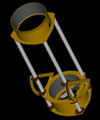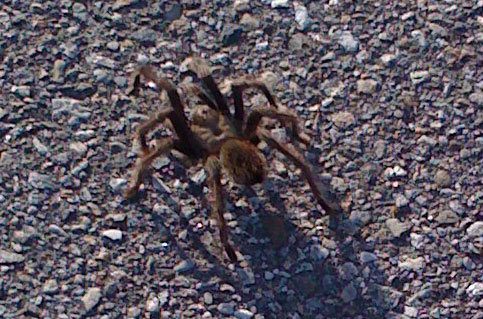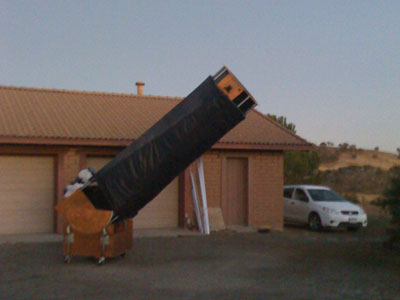After a short (55 minutes) and pleasant drive, I arrived at Dinosaur Point early (around 4pm) because of the new access rules, and to have plenty of time to setup my equipment. Albert Highe, George Feliz and Peter Natscher arrived shortly after and setup right next to me. Dave Cooper, Jamie Dillon, Bob Jardine and Al Howard were a little further down the parking lot. What a great team of observers! (ok, Al doesn’t really count as an observer, but he’s cool nonetheless)
The wind was non-existant. The temperature dropped from the low 60s to the mid to low 40s, which is not a huge difference. This always helps with the seeing, especially in large newtonians. The transparency was about average until about 9pm, when it got slightly better. At 9:30pm, I did a NELM test in Triangulum and obtained 6.3, which is pretty good for the site.
Since I don’t have a whole lot of Herschel 400 targets left around this time of the year, I decided to observe mostly Herschel II objects, and finished the night with a couple of galaxy groups from Alvin Huey’s “Selected small galaxy groups” observing guide. Among the highlights of the night, we observed NGC 891 and M 33 through Peter’s 24″ Starmaster telescope. The views were absolutely breathtaking! We also looked at the hydrogen filaments inside M 1, which we also detected through George’s 13″ scope, and to a lesser extent in my own 12″ scope.
Overall, I was very pleased with the evening, and it reminded me of why I like Dinosaur Point so much: short easy drive, fairly good skies, setup on a paved parking lot, in bed by 2am after 6+ hours of observing! Below is my log for the night. Cheers!
Location: Dinosaur Point [Elevation 648 ft]
Telescope: Meade Lightbridge 12″ F/5
Eyepieces used:
- Televue Panoptic 27mm (56x – 1.2° TFOV)
- Televue Nagler 16mm type 5 (95x – 52′ TFOV)
- Televue Nagler 9mm type 6 (169x – 29′ TFOV)
- Televue Nagler 7mm type 6 (217x – 22′ TFOV)
- Televue Nagler 5mm type 6 (305x – 16′ TFOV)
(All times are PST)
NGC 7184 GX Aqr 22h03m13.7s -20°45’54″ 11.7 mag 06:20pm
Moderately faint slightly elongated core, stellar nucleus, very faint halo elongated 3×1 ENE-WSW. Very faint superimposed star about 1′ ENE of nucleus. Fairly bright star at the ENE end of the halo.
NGC 7218 GX Aqr 22h10m45.0s -16°36’39″ 12.4 mag 06:40pm
2′x1′ elongated NNE-SSW. Gradually brighter toward a moderately faint core. Moderately bright superimposed stars 1′ E and 1′ NNE. Best seen at 217x.
NGC 7171 GX Aqr 22h01m35.0s -13°13’17″ 13.1 mag 06:50pm
Moderately large, very low surface brightness, only very slightly brighter in the core. Elongated 3:2 NW-SE. Extremely faint superimposed star 1′ E.
NGC 7377 GX Aqr 22h48m20.9s -22°15’31″ 12.1 mag 07:10pm
Small (about 1′ in diameter), round and fairly bright. Stellar nucleus. A small grouping of 5 fairly bright stars is located just SW of this galaxy.
NGC 7392 GX Aqr 22h52m21.9s -20°33’18″ 12.6 mag 07:20pm
2′x1′ elongated WNW-ESE. Stellar nucleus embedded inside a fairly bright small core.
NGC 7600 GX Aqr 23h19m26.0s -07°31’25″ 12.9 mag 07:35pm
1.5′x1′ elongated ENE-WSW. Moderately faint stellar nucleus.
NGC 7156 GX Peg 21h55m04.6s +02°59’32″ 13.3 mag 08:00pm
Small (about 1′ in diameter), round, dim, fairly uniform, only slightly brighter core.
NGC 7177 GX Peg 22h01m10.3s +17°47’23″ 11.9 mag 08:10pm
Round bright core, about 1′ in diameter, surrounded by a faint halo 2.5′x1.5′ elongated E-W. Stellar nucleus. Best seen at 217x.
NGC 7332 GX Peg 22h37m54.1s +23°51’14″ 12.0 mag 08:25pm
Very bright stellar nucleus embedded inside a bright compact core. Moderately faint halo roughly 2.5′x45″ elongated NNW-SSE. Forms a beautiful pair with NGC 7339 at 217x.
NGC 7742 GX Peg 23h44m47.4s +10°49’32″ 12.3 mag 08:50pm
Small (about 1′ in diameter), round, fairly bright, gradually brighter to a stellar nucleus. Mag 12.7 star just 1.5′ ESE.
NGC 23 GX Peg 00h10m25.7s +25°59’00″ 12.8 mag 09:05pm
Small (< 1') round faint halo, fairly bright almost stellar core. A fairly bright star is at the SSW end. Forms a nice pair with dimmer NGC 26.
NGC 604 BN Tri 01h35m11.7s +30°50’17″ mag 09:25pm
This nebula physically belongs to M33. Seen easily in a 12″ scope as a bright round patch about 1′ in size. In Peter Natscher’s 24″ scope, its shape appears slightly irregular.
NGC 598 (M 33) GX Tri 01h34m26.5s +30°42’53″ 6.4 mag 09:25pm
Barely detected naked eye. Easily seen in 9×50 finder scope, including the broad S-shaped spiral structure. Elongated 3:2 NNE-SSW. Large bright round core. Appears amazing in a 12″ scope, with lots of fine details easily visible in the spiral arms. Absolutely dazzling though Peter Natscher’s 24″ scope! Several NGC objects physically belong to M33: NGC 604, NGC 595, NGC 592 and NGC 588. All were seen very easily in a 12″ scope.
NGC 7640 GX And 23h22m36.4s +40°54’19″ 11.6 mag 09:40pm
6′x1.5′ elongated NNW-SSE. Moderately faint halo with a slightly brighter core. Slight impression of mottling. Fairly bright superimposed star just SE of the core. 2 superimposed stars in the halo N of the core.
NGC 206 BN And 00h41m04.3s +40°47’34″ mag 09:45pm
Star cloud that physically belongs to M31. Located about 40′ SW of M31′s core. Roughly 5′x2′ elongated N-S. Fairly faint.
NGC 214 GX And 00h42m01.3s +25°33’29″ 12.9 mag 10:00pm
Fairly small (1.5′x1′), elongated ENE-WSW, moderately faint, pretty uniform, slightly brighter core. Barely detected stellar nucleus.
NGC 1068 (M 77) GX Cet 02h43m13.3s +00°01’54″ 9.7 mag 10:20pm
Roughly circular, moderately faint halo, about 2′ in diameter, very slightly elongated N-S. Bright slightly S-shaped core elongated 3:2 NE-SW containing a very bright stellar nucleus. Some mottling visible (hints of broader spiral arms emanating from the core)
NGC 672 GX Tri 01h48m30.0s +27°29’11″ 11.4 mag 10:50pm
5′x2′ elongated ENE-WSW, pretty uniform, moderately bright. Forms a nice pair with much dimmer galaxy IC 1727 located about 8′ SW.
NGC 925 GX Tri 02h27m54.9s +33°37’36″ 10.6 mag 11:10pm
4′x2′ elongated WNW-ESE. Moderately faint, pretty uniform, slightly brighter core. Many fairly bright field stars enhance the view.
NGC 890 GX Tri 02h22m38.8s +33°18’53″ 12.8 mag 11:15pm
Small (about 1.5′x45″) elongated NE-SW. Fairly bright, gradually brighter to an almost stellar nucleus.
NGC 68 group
Pretty compact. A few field stars distract the observer, making the 3 galaxies in the center harder to spot.
NGC 68
NGC 69 (very faint)
NGC 70
NGC 71
NGC 72
NGC 72A (very faint)
NGC 74 (very faint)
NGC 383 group
Fairly bright members, loose group.
NGC 373 (faint)
NGC 375 (faint)
NGC 379
NGC 380
NGC 382
NGC 383
NGC 384
NGC 385
NGC 386 (faint)
NGC 387 (very faint)
NGC 388





























